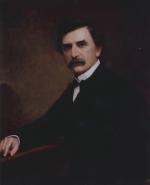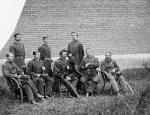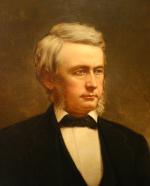![header=[Marker Text] body=[The birthplace of John F. Hartranft, Civil War hero and Pennsylvania Governor, 1873-79, is to the right on the side road. He reorganized the State Militia as part of the National Guard ] sign](http://explorepahistory.com/kora/files/1/10/1-A-3B8-139-ExplorePAHistory-a0m8c5-a_450.jpg)
Mouse over for marker text
Name:
John F. Hartranft
Region:
Philadelphia and its Countryside/Lehigh Valley
County:
Montgomery
Marker Location:
Sanatoga Rd., SW of Fagleysville
Dedication Date:
May 6, 1947
Behind the Marker
Governor John Hartranft (1830-1889) is remembered primarily for his role in three deadly events. As provost marshal of the Washington arsenal, in 1865 he signaled the executioner to hang the four men convicted of participating in the conspiracy to assassinate President Lincoln. As governor of Pennsylvania, he permitted the execution of the  Molly Maguires and directed the suppression of the
Molly Maguires and directed the suppression of the great railroad strike of 1877. In the latter case, he became the first governor in United States history to request federal troops to put down a labor uprising.
great railroad strike of 1877. In the latter case, he became the first governor in United States history to request federal troops to put down a labor uprising.
Hartranft, like his predecessor John Geary and successor
John Geary and successor Henry Hoyt, owed his fame to the Civil War. Born in Montgomery County to a landowner and innkeeper who sent him to Union College in New York, he worked as a civil engineer, deputy sheriff, and lawyer before Governor
Henry Hoyt, owed his fame to the Civil War. Born in Montgomery County to a landowner and innkeeper who sent him to Union College in New York, he worked as a civil engineer, deputy sheriff, and lawyer before Governor  Andrew Curtin appointed him colonel of the Fourth Pennsylvania Volunteers after the Confederacy seceded. Hartranft served respectably throughout the conflict and was well-liked by his men, who called him "Old Johnny."
Andrew Curtin appointed him colonel of the Fourth Pennsylvania Volunteers after the Confederacy seceded. Hartranft served respectably throughout the conflict and was well-liked by his men, who called him "Old Johnny."
Promoted to general at the war's end, he then decided to make a career of politics. Supported by Republican state boss Simon Cameron, who recognized the voter appeal of his war record, Hartranft ran successfully for state auditor general, a position that gave him oversight of the finances with which Cameron and his associates played fast and loose during Geary's two terms as governor from 1867-1873.
Simon Cameron, who recognized the voter appeal of his war record, Hartranft ran successfully for state auditor general, a position that gave him oversight of the finances with which Cameron and his associates played fast and loose during Geary's two terms as governor from 1867-1873.
Supported by Cameron, Hartranft then won election as governor in 1872 and 1875, and in both terms remained faithful to Cameron and Cameron's main client, the Pennsylvania Railroad (PRR). In 1877, when the seventy-eight-year-old Cameron resigned his Senate seat, Hartranft, as arranged, appointed Donald Cameron ,the Senator's son, to replace him.
Donald Cameron ,the Senator's son, to replace him.
As governor, Hartranft supported modest municipal reforms and the rights of workers to organize. He also created the Insurance Department to protect policyholders but had the misfortune of serving while the nation was in the midst of prolonged and painful economic recession, triggered by a financial panic in 1873. Four years later, in July 1877, the Baltimore and Ohio Railroad's announcement of its third 10 percent wage cut triggered the first nationwide wildcat strikes in American history. As the strikes spread from Martinsburg, West Virginia, to cities across the nation, crowds in cities in Illinois, Maryland, and Pennsylvania turned out to stop trains from moving.
The worst riots broke out in Pittsburgh. After Pennsylvania Railroad (PRR) President Thomas A. Scott called for "a rifle diet for a few days," Governor Hartranft sent the National Guard from Philadelphia. When outraged protesters cornered the troops in a PRR roundhouse, the soldiers opened fire, killing twenty and wounding many others. In response, furious workers destroyed tracks, roundhouses, and engines, along with thirty buildings, including Union Station.
sent the National Guard from Philadelphia. When outraged protesters cornered the troops in a PRR roundhouse, the soldiers opened fire, killing twenty and wounding many others. In response, furious workers destroyed tracks, roundhouses, and engines, along with thirty buildings, including Union Station.
As protests spread to Altoona, and Reading, where National Guard troops killed another ten people, Hartranft called out more militia and asked President Rutherford B. Hayes - whose disputed electoral victory had been engineered in part by Scott - to send federal troops. Hayes solved the constitutionality of this request, as it was a stretch to call the strikes the "domestic insurrection" that federal law authorized the president to put down, by noting the railroads were essential for the postal service, a constitutionally stipulated federal duty, to deliver the mail.
Reading, where National Guard troops killed another ten people, Hartranft called out more militia and asked President Rutherford B. Hayes - whose disputed electoral victory had been engineered in part by Scott - to send federal troops. Hayes solved the constitutionality of this request, as it was a stretch to call the strikes the "domestic insurrection" that federal law authorized the president to put down, by noting the railroads were essential for the postal service, a constitutionally stipulated federal duty, to deliver the mail.
The railroad strikes of 1877 were the first of a succession of bloody battles between capital and labor not just over wages and work conditions but the constitutional and legal rights and obligations of American employers and workers. In the decades that followed, Pennsylvania's state government and courts, as much as any other state in the state in the nation, aligned itself closely with business interests.
On the local level, Pennsylvania workers were able to achieve small political victories, the most notable of which was the election of labor organizer Terence Powderly as the mayor of Scranton in 1878. Cities throughout the state built armories in which the upper and middle classes could find safety and the arms to counterattack in the event of an insurrection. The state also strengthened the National Guard, which Hartranft led after he left office in 1878. For his good work defending the state and remaining loyal to the machine and the railroads, Hartranft also received two prize patronage plums: appointment first as postmaster of Philadelphia and then as Collector of the Port. Hartranft died in 1889, after which he was buried in Norristown.
Terence Powderly as the mayor of Scranton in 1878. Cities throughout the state built armories in which the upper and middle classes could find safety and the arms to counterattack in the event of an insurrection. The state also strengthened the National Guard, which Hartranft led after he left office in 1878. For his good work defending the state and remaining loyal to the machine and the railroads, Hartranft also received two prize patronage plums: appointment first as postmaster of Philadelphia and then as Collector of the Port. Hartranft died in 1889, after which he was buried in Norristown.
Hartranft, like his predecessor
Promoted to general at the war's end, he then decided to make a career of politics. Supported by Republican state boss
Supported by Cameron, Hartranft then won election as governor in 1872 and 1875, and in both terms remained faithful to Cameron and Cameron's main client, the Pennsylvania Railroad (PRR). In 1877, when the seventy-eight-year-old Cameron resigned his Senate seat, Hartranft, as arranged, appointed
As governor, Hartranft supported modest municipal reforms and the rights of workers to organize. He also created the Insurance Department to protect policyholders but had the misfortune of serving while the nation was in the midst of prolonged and painful economic recession, triggered by a financial panic in 1873. Four years later, in July 1877, the Baltimore and Ohio Railroad's announcement of its third 10 percent wage cut triggered the first nationwide wildcat strikes in American history. As the strikes spread from Martinsburg, West Virginia, to cities across the nation, crowds in cities in Illinois, Maryland, and Pennsylvania turned out to stop trains from moving.
The worst riots broke out in Pittsburgh. After Pennsylvania Railroad (PRR) President Thomas A. Scott called for "a rifle diet for a few days," Governor Hartranft
As protests spread to Altoona, and
The railroad strikes of 1877 were the first of a succession of bloody battles between capital and labor not just over wages and work conditions but the constitutional and legal rights and obligations of American employers and workers. In the decades that followed, Pennsylvania's state government and courts, as much as any other state in the state in the nation, aligned itself closely with business interests.
On the local level, Pennsylvania workers were able to achieve small political victories, the most notable of which was the election of labor organizer
Beyond the Marker









